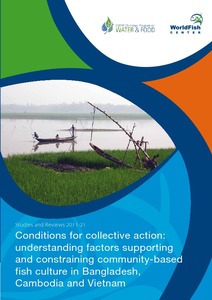Commercializing smallholder value chains for goats in Mozambique: A system dynamics approach
Goat producers in Inhassoro follow traditional management practices that lead to low supply of low quality goats. This has negative impacts on profitability, and on market access. Traders who buy in the Inhassoro locality buy only small volumes, and buyers from external markets are unaware of potential market supply in Inhassoro. This interaction of production constraints and limited information flows in the value chain was addressed using a system dynamics model for various commercialization scenarios.
Commune agroecosystem analysis to support decision making for water allocation for fisheries and agriculture in the Tonle Sap wetland system
The Project on Commune Agroecosystem Analysis to Support Decision Making for Water Allocation
for Fisheries and Agriculture in the Tonle Sap Wetland System was undertaken with the aim of
improving fisheries considerations in the Commune Agroecosystem Analysis (CAEA) process
undertaken in Cambodia, to facilitate better planning at the commune level. Under this project a
number of changes were made to the CAEA tools and process and pilot tested in an adaptive,
iterative manner in four communes – two that had conducted a CAEA previously and two that had
Competitive farming strategies and their effect on water provision and profitability among smallholder farms: the case of Muooni Dam site, Kenya
Conditions for collective action: Understanding factors supporting and constraining community-based fish culture in Bangladesh, Cambodia and Vietnam
Flood-prone ecosystems in South and Southeast Asia are traditionally farmed with deepwater rice followed by post-flood rice culture during the dry season. During the
flood season, the same land is inundated, creating an open-access water body subject to multiple uses by multiple users. Fish production in these areas is based on
Conservation agriculture for the dry-land areas of the Yellow River Basin: Increasing the productivity, sustainability, equity and water use efficiency of dry-land agriculture, while protecting downstream water users
Soil erosion is a major problem in the Yellow River Basin: the river is one of the most
sediment-laden in the world. Although there is a rainfall gradient from 750 mm in southern
Shandong, to 200mm per year in northern Ningxia, most of the rainfed cropping area is in
regions with more than 400 mm per year – it is here that the project concentrated.
Conservation agriculture (featuring reduced or zero tillage, mulch retention, crop rotations
and cover crops) offers a possible solution to problems of soil erosion and low crop
Constraints to the development, operation and maintenance of spate irrigation schemes in Ethiopia
Flood-based farming is among the potential options in ensuring access to water for crop and livestock production for small-scale farmers in the arid and semiarid lowlands of sub-Saharan Africa, and Ethiopia in particular. Flood-based irrigation while inexpensive is rooted in tradition in many rural communities which is in contrast to many other irrigation types which are unavailable (in terms of water source, technology or capacity) or are costly to develop.
Contribution of informal shallow groundwater irrigation to livelihoods security and poverty reduction in the White Volta Basin (WVB): Current status and future sustainability
Shallow groundwater irrigation (SGI) using hand-dug shallow wells and dugouts is expanding, in the WVB, and is becoming attractive to farmers throughout. SGI is farmer-driven and has
developed without any government or donor involvement. The production of vegetables and cash
crops during the dry season utilizing SGI has provided farmers with a supplemental source of
income and an alternative to seasonal urban migration. Although SGI has been increasing
substantially, the extent of this practice is not documented.This project has help assess, the
Credit policy and intensification in mixed crop-livestock systems: A modelling perspective
Using a household bioeconomic modelling approach, this paper analyses the impact of advancing in-kind credit in the form of fertilizer and seed on smallholder farmers with different levels of wealth in the Ethiopian highlands. Cropland allocation and household consumption patterns are examined in relation to credit availability. The paper then explores appropriate policy mechanisms for advancing credit to smallholder farmers in order to encourage intensification.








